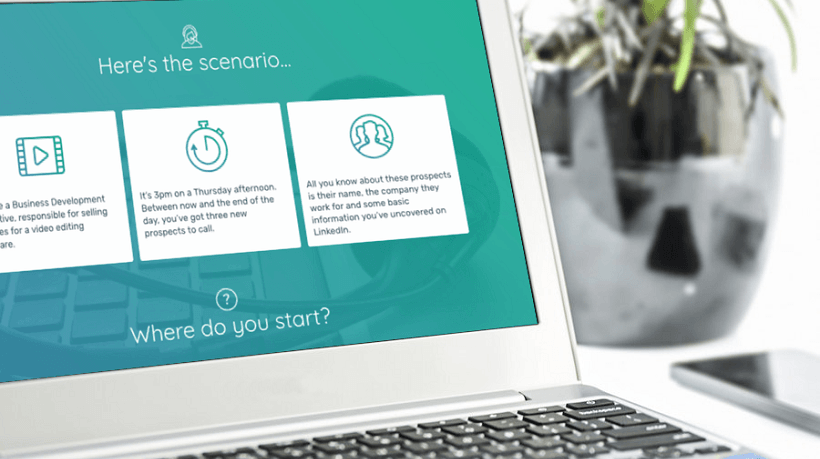Gamification Fails And Examples Of How To Address Them
Spending time playing games at work may seem like a waste of time, but when done well it can reveal bad habits, demonstrate consequences, and motivate change. Learners are turned off by dull eLearning, but you need to be careful not to patronize them with childish games to jump on the gamification bandwagon. If you can develop a simulation that’s relevant and challenging, you’ll start to see results.
Try out our Sales Simulation, powered by Elucidat.
#1: No Clear Goal
When you’re explaining how to play a game to a friend, you usually start with the aim. It might be to reach the finish line fastest, get the most points or expand into the most territory. A game with no goal can feel pointless.
Tip
Try creating a goal in the all-important first 7 seconds of your learning experience, to hook your learners in and give them something to strive for. Make sure the goal of the game links closely to the learner’s real life goal (the objective of the learning). It needs to be:
- Relevant.
- Realistic.
- Relatable.
Inspiration
Get some inspiration from this example, built in Elucidat’s authoring tool. The simulation forces the learner (a new salesperson) into the driver’s seat, putting them in the place of a Business Development Executive trying to meet their target with the final three leads of the day.
#2: Too Superficial
Once you’ve hooked your learners in well with a clear goal or objective, you need to maintain engagement. Too much traditional learning with no story can turn people off, and your content will slip into the category of “dull eLearning”.
Tip
Using video and audio to tell your story can help increase the drama and keep learners hooked. This can be particularly powerful with emotive areas such as ethics, people management and wellness.
If audio and video are a bit of a stretch, you can still tell your story with words and images. Make sure you pose challenging questions, get people to make fast decisions and dish out rewards and punishments; but let people learn through these consequences rather than lengthy written feedback.
Inspiration
In our Sales Simulation example, we used recorded phone calls to create a quick and inexpensive audio-led experience.

#3: Lack Of Pressure
If there’s nothing at stake and your simulation is too easy, your learners won’t feel invested and they will zone out. If there’s too much pressure or it’s too hard they’ll give up. Striking a balance can be tricky!
Tip
Prototype and test until your simulation induces the perfect amount of anxiety that keeps people hooked and motivated to win.
Inspiration
We used Elucidat’s sophisticated countdown timers and assessment functionality in our Sales Simulation example to create a weighted “killer question”, which learners only have 15 seconds to answer. Tricks like this help increase the pressure and keep learners in the moment.

#4: No Consequences
When it comes to gamification in eLearning, if you don’t have consequences, the learning will be limited.
Tip
Rather than telling your learners what to do, an effective game will reward good decisions and show them the consequences of bad ones, and allow them to draw conclusions. This keeps it real and practical, rather than abstract and theoretical.
Inspiration
Another tool we used in our sales example is to award points and badges throughout a simulation. These can also use rules to trigger consequences based on specific learner pathways.

#5: Being Afraid Of Repetition
On the face of it, we tend to think that repetition is boring, but dig a little deeper and you’ll realize that repetition is a common feature in gameplay. You frequently find yourself facing the same problems, using the same weapons or having to try again after a failed mission.
You’re more likely to remember something you did (or couldn’t do!) multiple times, rather than just doing it once.
Tip
Don’t be afraid to add fail points to your game or simulation, where players are kicked out and have to start again. It’s likely to aid their learning. Elucidat makes this easy for you with rules and branching.
A Few Final Things To Consider
If you can get the game mechanics right, the fun (and effective) user experience will take care of itself. A few final things to consider:
- Who is your audience? What type of simulation will work for them?
- How will your learners be accessing this content? You’ll need to consider mobile design for learners on the move.
- How will you know if your game is working? Make sure you have access to analytics, and use these to tweak and improve your game to ensure it’s hitting that all important sweet spot.
Need a better tool to design more effective eLearning? Try Elucidat for free.









